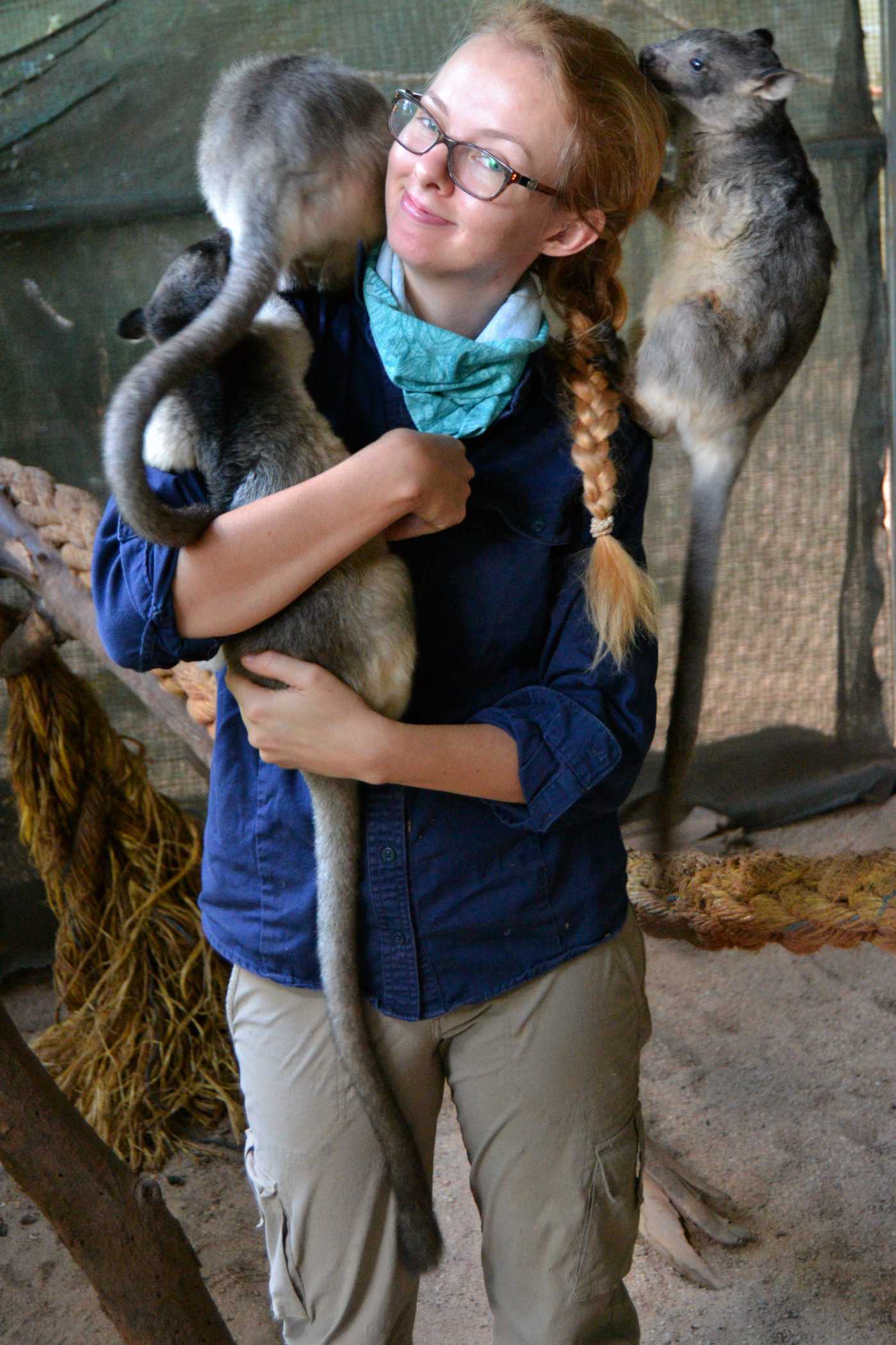My mornings are typical of anyone with kids. As I prep breakfast, julienning sweet potato and rinsing chickpeas, Misty tugs at my leg, looking for attention. She’s needy and wants to be at the centre of everything. I nudge her off gently. Without hesitation, Misty grabs at my ankle. Her real mother died when she was quite little, so I think attention-seeking can be forgiven.
‘Hey, sweet thing,’ I murmur to Misty as she wins momentarily. Scooping her up and onto my shoulder, I continue to peel and chop. Misty, like the other two “kids” here at the Tree Roo Rescue and Conservation Centre (TRRCC), is a Lumholtz’s Tree Kangaroo joey. She sags contentedly against my cheek. Darker-furred Bear and runt-of-the-group Ella charge around behind me, clomp-clomp-clomping over polished floorboards, full of energy and mischief. Bear’s mother was killed by dogs, Misty’s was hit by a car, and Ella’s abandoned her in the middle of a field.

Like all the tree roos at the centre, these joeys wouldn’t be able to survive on their own. However, unlike the others, Misty, Bear, and Ella are looking forward to a release back into the wild when they are older.
So, why aren’t the other roos being released? They are blind. Over the last few years, an unprecedented increase in blindness among Lumholtz’s Tree Kangaroos has led to more roos needing care. Lumholtz’s Tree Kangaroos only live in a relatively small area, centred on the Atherton Tablelands in Far North Queensland, so this is particularly worrying for the species. Although some of the roos at TRRCC are blind due to eye injuries or severe cataracts, most are blind from an unknown cause. There are a few competing hypotheses as to where this neurological blindness stems from.
Tablelands veterinarian Amy Shima has stated it may be a form of toxoplasmosis, caused by the exposure of tree roos to feral cat faeces. Meanwhile, TRRCC founder Dr Karen Coombes believes the blindness may be due to an increase of harmful toxins in native rainforest leaves (the tree roos’ main food source) exacerbated by heat stress. More research is underway to discover the why of this blindness but, in the meantime, life goes on here at TRRCC. So, I put Misty down and Karen and I head out for our daily breakfast deliveries.
Murphy is waiting eagerly at his gate for breakfast, bouncing enthusiastically as I enter the enclosure. I put the tray under his nose and he sniffs around until he finds what he’s looking for – banana! He gobbles up one piece eagerly, then hops, tail up, to his feeding station. It’s easy to forget that Murphy is blind, with his chipper nature and innate charm, but I am careful every morning to put his breakfast in the exact same place. I forgot one day to place it just so, and the result was an over-eager Murphy disappointedly nosing around after hopping directly onto his food.


After Murphy, I bustle along through the other enclosures, making small talk, positioning meals, raking out leaves and poo, and refilling bowls of water and dirt (eaten to aid in digestion) as needed.
Each tree roo has their own backstory and personality. Rosie and Mickie love being fussed over, Lily has a purple cushion she adores cuddling, and Matty is a fiend for Umbrella Tree. Other than their blindness, the roos here have one major commonality: in a busy world often disconnected from nature, people took the time to save their lives. A man put himself at risk by rescuing Lee from a cassowary attack. Misty was brought in because, when her mum was killed by a car, a young boy insisted his mother pull over to check the pouch. A passerby saved Lily from the dogs attacking her. The stories continue, with disoriented roos found in the middle of town or hopping in circles by busy roads.
When the enclosures are tidied up and the adult roos are fed, we take the joeys for their daily outing to one of the larger enclosures. For Misty, Bear, and Ella, this playtime is a game, where they scurry up my legs, use my face as a handhold, and rocket from rope to rope. However, this is also an important educational tool for the joeys. Daily enrichment helps to build up muscles, climbing skills, and coordination. A simple romp here is one of the first steps in helping the joeys survive when they’re out on their own.

A lot of TRRCC’s roos will move to zoos throughout Queensland, where their presence will help to educate visitors from all around the world. Ideally, TRRCC would be unnecessary. But, for the moment, laughing as the joeys run up and down the ropes and munch on leaves, life doesn’t seem so bad.
TRRCC is run by Karen Coombes and her partner Neil McLaughlan and supported by the generous efforts of volunteers and donors near and far. Visit their website to find out more about the fantastic work they do.
Banner image of Lily courtesy of Chelsea Smith: Lily’s blindness is due to cataracts.


Leave a Reply